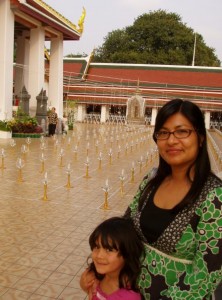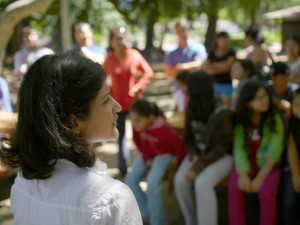Identity has always been a vexing issue for me. I was born in Nepal, in the capital, Kathmandu, where identity is established first by ethnic group. There are more than 100 distinct ethnic groups and castes in the Kingdom of Nepal. I am Newari, the original inhabitants of the Kathmandu Valley, and a Sakya, one of the families or clans that represent the monks and nuns of the Buddhist community.

When I was 5 years old my family migrated to Thailand where I attended an American international school in Bangkok. I was the only Nepalese person in my school. To be anything other than Thai, Chinese or Indian – the majority of the student body, was to be looked down upon or considered an exotic “other” so I learned to keep my ethnicity to myself and didn’t correct people when they assumed I was Thai or Indian.
As I got older, I appreciated my “uniqueness” but I further honed my ability to mingle and pass in and out of ethnic groups and cliques, by learning their languages and mannerisms. When I migrated to the United States to go to college this knack for blending in became something of a superpower. But, like any superpower there are some drawbacks. What I lacked was any sense of community or belonging, I felt like an imposter, or worse, invisible.
My work at CAAM, where the goal is to represent the vast, complex diversity of the Asian American experience has been informed and reinforced by my own life journey. I believe in the value of individual experiences but also in the value of being part of a community. A community can offer support when an individual is in need and strength when it comes to having one’s voice heard.
Until now, I categorized myself as South Asian but I always felt that the term South Asian represented the dominant group of that subcontinent, India. I am South Asian and Nepalese; the Nepalese language is similar to Hindi but Newari, my ethnic language, is closer to Tibetan and Burmese. So Himalayan is a more accurate descriptor of my culture and ethnicity.
Having the term Himalayan American to describe myself strengthens my identity and allows me to explore what makes us a community and how we can strengthen that network. But I am also still South Asian and Asian American because there I enjoy being associated to these larger communities for both political and social reasons. Identity politics in the US is a whole other can of worms which we’ll leave for another blog post! The question of identity is always going to be complex.
But the Himalayas also conjure up images of tranquil, idyllic Buddhist hamlets of Shangri-la. This is just as much a stereotype as a Bombay sex worker or a security guard, which is what many an Indian acquaintance has brought up minutes after being introduced.
Those two stereotypical images are the reasons why I work in media and believe in the importance of telling your own story. Our own stories, be they Himalayan or otherwise are always much more interesting and nuanced than anything someone else creates about us.
What does it mean to be Himalayan American? Do we need this term to better describe ourselves? Why not Asian American or South Asian American? The answer lies in the mountain range that connects Bhutan, Nepal and Tibet, the Himalayas.

The Himalayan American community is a new ethnic group so no population numbers exist. When confronted with the choices on census forms many check “other”. But one number is concrete, the 50,000 Nepalese-Bhutanese refugees that the United States government will be relocating in the coming years. Oakland, California and Houston, Texas will receive the majority of these ethnically Nepalese families who were expelled from Bhutan. Tibetans and Nepalese have been settling in the San Francisco Bay Area for generations and the numbers have increased recently due to social unrest in Nepal. The city of Berkeley is one of the few cities that recognize Tibet as an autonomous region.
Grassroots organizations like Sahayeta and Community Health for Asian Americans have been working to provide much needed health services, education and job training to assist the Himalayan American community in the Bay Area. This month, CAAM and these two organizations along with the Nepalese professional association CAN-USA, will host the first Himalayan Youth Leadership Summit in Oakland.
The Himalayan community, especially the youth are ready to take the next step towards defining their identity here in the US. The goals of the Summit are to empower youth to see their own futures in a positive light, to provide a platform for the youth and the community to share their ideas and talents and finally, to create an alliance that encourages youth leadership and growth.
If you are a Himalayan youth or are interested in these issues please check out the Himalayan Youth Leadership Summit.
Sapana Sakya is Public Media Director at the Center for Asian American Media and the producer and editor of the award-winning DAUGHTERS OF EVEREST.
Related Links
Sahayeta
http://www.sahayeta.org/
Community Health for Asian Americans
http://www.chaaweb.org/]
Computer Association of Nepal-USA
http://www.can-usa.org/
Youth Leadership Summit Registration
http://www.sahayeta.org/events/index.php?action=add&eventID=4





I think you articulate the complexity and multiplicity of identity so thoughtfully in this post. I like how you illustrate how identity is not fixed, changes over time as communities and context change. I also appreciate how you connect identity to to history and power.
Thanks Michella, thanks for drawing such articulate conclusions from my blog!
Fantastic blog! Thanks Sapana, for sharing your
personal story. I can definitely relate to feeling invisible and having
to respond to ignorant comments that conjure uncomfortable stereotypes. I also have felt that the term “South Asian” is used, all too often, to refer only to people of Indian descent.
Well written! This is indeed an invisiable voice of people like us. I felt that you have given a voice for people who are struggling to find one’s identity in amidst of strong current of globalization and glocalization. Theoretically we are a global citizen but at the same time this globe stays beautiful with cultural diversities. One way to keep cultural diversity alive is to be aware of each and individual’s root and appreciate the fact of its dynamic force, an important organism of the person that makes us as who we are.
I think a hybrid identity — and an unpected hybrid at that — enriches us and perhaps pushes others to adjust their immigrant paradigm. Diasporas and migrations happpen all the time. For my great grandfather it was a simple wanderlust that sent him to Havana, Chicago and finally, Rangoon. I’m the third generation on both sides of my Chinese family to be born in Burma. At home we speak blended English, Burmese and two Chinese dialects. Dad’s family can definitely surprise people with their Bengali and (very) rusty Hindi. Having multiple meanings systems operating concurrently can only start one in life already coloring outside the lines. Granted it wasn’t too much fun for growing up in Orange County a decade before anyone else seemed to leave Burma, but I thoroughly enjoy it now. I hope you do as well.
I had robbed my house, I had robbed my country. For this sin my house
had ceased to be mine, my country also was estranged from me” (144).
This represents a character turning point for Bimala
Looking over the US laws, it seems that they would need to prove that the order to hack the phones came from Murdoch himself, and barring that there is not much more that can be done to Murdoch or even Fox News. Granted if the FBI does find something tying Fox News to the hacking of 9/11 families, well that would spell doom for the network. And it would lose a lot of creditability with the very people they aim to put in chairs and on couches night after night.
HI,
Its brilliant article guys.
Thanks
Its very good article. Thanks for posting.
Beautiful
Thanks for sharing
Definitely Facebook (Like Pages and Communities) are the
first and foremost platform to get as many users as good your campaigns is
running. Although you need to set up blogs first for engaging your users with
you because when you provide information then they could take interest in your
business and i believe SocialAliens(dot)com most trustable place to buy Real
Targeted Facebook fans.
I cogitate you facile the complexness and multiplicity of operator so thoughtfully in this stake. I similar how you expound how sameness is not leaded, changes over abstraction as communities and circumstance convert. I also understand how you infix individuality to to history and knowledge.
buy cheap facebook fans
It is interesting to know about this information. It may not
directly concern about us, but at least we have this consciousness what is
really happening..
I think you articulate the complexity and multiplicity of identity so
thoughtfully in this post. I like how you illustrate how identity is not
fixed, changes over time as communities and context change. I also
appreciate how you connect identity to to history and power.
jam jars